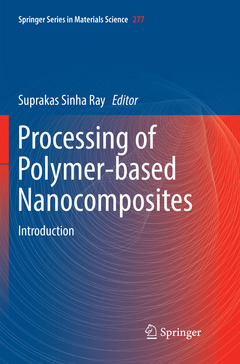Description
Processing of Polymer-based Nanocomposites, Softcover reprint of the original 1st ed. 2018
Introduction
Springer Series in Materials Science Series, Vol. 277
Coordinator: Sinha Ray Suprakas
Language: English
Subject for Processing of Polymer-based Nanocomposites:
Keywords
Polymer nanocomposites; nano-additive chemistry; electrospinning; polymer blends structures; Nanoparticle synthesis; functionalisation process; polymer matrix; polymer blend morphology; In-situ polymerization; solution casting; melt compounding; water assisted compounding; coating technologies; rheology; synthesis of nanomaterials; functionalization of nanomaterials; nanoclay; clay-containing polymer; melt processing of polymers
Publication date: 12-2018
Support: Print on demand
Publication date: 09-2018
Support: Print on demand
Description
/li>Contents
/li>Biography
/li>Comment
/li>
Provides a comprehensive coverage of the processing technologies, including emerging ones such as electrospinning
Discusses structural elucidation techniques, such as x-ray diffraction and scattering, microscopy and spectroscopy, rheology
Describes the tools used for characterization of the level of dispersion of the nanoparticles in a polymer matrix, the resultant structure and properties
Explains not only the functions of the nano-additives for polymers, but also the synthesis process and their functionalization
These books may interest you

Processing of Polymer-based NanocompositesProcessing-structure-property-performance relationships 105.49 €

Processing of Polymer-based NanocompositesProcessing-structure-property-performance relationships 105.49 €

Polymer Nanoclay Composites 120.27 €

